Supervised by: Yash Salunkhe BSc (Hons). Yash is currently completing his MPhil in Economic Research at the University of Cambridge. He gained his BSc Econometrics and Mathematical Economics (EME) at the London School of Economics (LSE) in 2018. From 2018-19, Yash worked in Venture Capital in Pune, India, evaluating startups with a positive social impact. From 2019-2021, he worked in Wealth Management, helping large institutions invest their portfolios above $25 million. He has co-founded 2 charities: one focuses on improving outcomes in under-funded schools in India and the other was involved in varied community development projects.
Abstract
In the modern digital era, artificial intelligence (AI) has emerged as a transformative technology capable of reshaping, remodeling and restructuring the financial sector and its many intricate parts. AI poses an extremely lucrative opportunity in the field of finance as it allows consumers and industries to have a piece of technology able to compute more data than ever done before. This research paper will examine the ways in which AI is being implemented into different sectors to reduce redundancy and the ways in which AI will be incorporated into these sectors in the near future. The ESG, Sustainable Financial Investment, Fraud Detection, Credit scoring and Corruption sectors will be explored to give an understanding of how AI will fold into the existing responsibilities, workload, management, and overall corporate operation.
Introduction
Throughout the past couple of years, AI has burst onto the scene, evolving from a theoretical and non-practical concept to a tangible and fascinating technology, impacting all of our lives. It has also become widespread as a powerful tool in the corporate world. The finance sector is one of the most data-intensive sectors globally, and has made a big transformation due to implementing AI. However, with all the good that AI is doing, has done, and will continue to do, there is fear that AI is uncontrollable, unstable and poised to take over everything we know about the workforce and people in general. In the present day, AI’s uses are quite fascinating. Companies are using AI in the finance sector to screen possible hires, decode complex financial data sets, create digestible information ready for application, and even implement these strategies and create courses of action.
In this paper, the roles of AI in the financial investment sector will be looked at and analyzed for its opportunity in the near future. The paper will also summarize AI’s effects of the sub-sectors of finance and financial skills, such as risk management, portfolio optimization and enhanced decision making and will also analyze case studies regarding the future implementation of AI into finance and sustainable investments. It will go on to summarize how these nuances will help both the everyday investor and the financial institutions which are both rapidly implementing AI into their repertoires.
As well as the roles of AI in the financial investment sector, AI also has many major roles in fraud detection and credit scoring. The fraud detection and credit scoring section of this essay iterates what both of these are and the ways in which AI detects fraud and credit worthiness, as well as the impacts on the financial market due to AI. This is done by AI analyzing large amounts of data, using predictive analytics, identifying questionable transactions, detecting trends and flagging suspicious behavior. Additionally a case study is included about a Nordic bank, which has recently implemented AI into its fraud detection systems. This case study clearly demonstrates the significant and substantial positive impact AI has both on bank/company itself but also on the financial market, making it both secure and stable.
AI plays not only a major role in credit scoring and fraud detection in general, but also in banking fraud and banking security. This paper’s banking security and corruption section will analyze the impacts of artificial intelligence on the banking sector, and assess AI’s potential for legal and illegal tasks in finance. This paper will also examine current proposed regulations for AI, thereby theorizing what a future of AI in the banking industry will look like. Banking fraud is an extremely costly industry, and this paper outlines the ways that artificial intelligence will reduce the cost of banking fraud by preventing it. This paper also discusses the ways that AI can make this industry even more costly, by expanding what banking fraudsters can do with AI. However, artificial intelligence holds ultimately positive benefits for the future of banking fraud, through effective regulations and laws. Will also talk about ESG investments and how AI has played a pivotal role in creating solutions.
Most threatening to the human psyche and state of mind, however, is AI’s financial implications over the next few years and, moreover, the future. AI is expected to have a disrupted effect on the composition of labor markets, swapping laborers for flawlessly engineered robots designed to be perfect and troubleshoot with ease. Many optimists believe that AI’s productivity and the effects of its reinstatement will be more than enough to compensate for the disrupted effect. So how, specifically, will AI replace us in the workforce? Short Answer: it really wont.
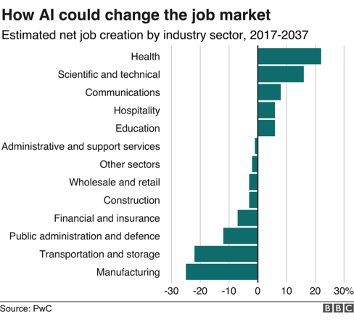
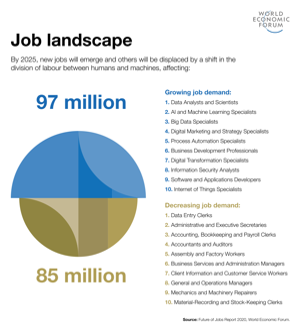
Contrary to popular belief, AI will not create a wipeout of the entire global workforce but rather will shift the landscape of it. A projected net of 12 million jobs will be created by 2025 due to AI’s involvement, and will continue to create high paying jobs (replacing low-wage labor such as manufacturing and transportation with healthcare and programming.) As well as creating more higher-paying jobs, AI also creates a more stable and secure financial market. AI will take over some jobs in the fields of retail, insurance, transportation and manufacturing but will create jobs in the health, hospitality, and education sectors.
With AI’s capability to decode vast quantities of data, identify hidden patterns and make complex decisions and inform the user, AI has the ability to transform the lives of not only the corporate higher earners, company owners, and entrepreneurs, but also the lives of everyday people and families, and the success of communities, and the standard of living for underdeveloped countries.
Section organization goes as follows: Section 1 – Sustainable Financial Investments, Section 2 – Fraud Detection and Credit Scoring, Section 3 – Banking Security, Section 4 – ESG Investments.
Sustainable Financial Investment
Since the beginning of financial investments, loans, and bonds, we as consumers have been trying to find a ‘sure-fire’ way of seeing whether the product is volatile or destined for success. However, before the implementation of AI, there was no real surefire way outside of the human brain and intuition. No person could consistently know how someone else is thinking when it comes to the stock or bond market. Some investors are unaware and inexperienced, so their decisions might be rash, unexplainable and not backed by any valid reason other than a gut feeling. Some investors are a lot more advanced, making their moves a lot harder to predict since their experience will allow them to draw back to previous examples and base their decisions from there. No human brain, no matter how advanced, is able to track everything about these investors to know exactly what they will do if something happens to the stock. Humans aren’t able to make correct decisions (consistently) especially when the data needed is scattered around.
This unfortunate shortcoming of the human brain, however, can be and is being replaced with a much more intelligent tool. The intricate nature of financial markets coupled with the need for real-time analysis and informed decision making makes AI an ideal tool for investors and fund managers. AI’s capacity to process vast amounts of data and extract meaningful analysis in real-time will continue to transform decision making in the entire financial sector. While past investment strategies relied heavily on historical data and fundamental analysis, AI takes it a step further by incorporating other tangible factors such as sentiment analysis, social media trends, news articles and other important sources of data. This use of AI enables both investors and investing organizations to make more informed decisions, especially in today’s and the future’s markets.
One of if not the most important skill a successful investor must have in their repertoire is the ability to adequately evaluate risk and manage their investments accordingly. In the past, risk assessment models were often limited on their reliance on historical data and predetermined assumptions which are what caused the 2008 stock market crash – no one believed the outrageous idea that the entire housing market could fail. AI, on the other hand, excels at adapting its risk assessment models and it continuously learns from real time data. These algorithms can much more effectively analyze historical data (eliminating what isn’t relevant), identify trends and predict potential market downturns. This risk assessment empowers investors and financial institutions to take more effective preventative measures in case of market fluctuation.
With today’s ever changing economic outlook, changes in market performance in each sector are extremely common. Having an optimized portfolio which takes into account certain news, financial trends, spending patterns and other influencers of market outputs, is crucial in order to maximize profits of investments. AI algorithms have revolutionized portfolio optimization by providing the tools to construct and manage these portfolios. While traditional portfolio management relies on the investors ability to know all the news around them, it is not all that reliable because no one human can know all the relevant information and from it be able to analyze it and what it means for their portfolio. Not even the most powerful brain can compute that much data, but AI can, and can do it quite quickly. AI enhances the portfolio by accounting for a wider array of factors. They can incorporate variables such as risk appetite, investment goals and liquidity constraints. By taking these factors in conjunction with historical data, AI can suggest the optimal asset allocations that align with the investors preferences and tolerance. This AI driven approach ensures that portfolios are well balanced and consistently adjusted to reflect these changing markets, leading to better and more consistent returns.
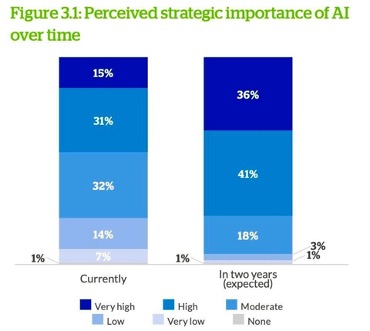
According to a recent forum conducted by the World Economic Forum (Davos Agenda, 2023), which surveyed various financial institutions and the workers inside those firms, at least 85% already use some form of AI or machine learning, 77% believe that AI will become essential to their business in the next two years (likely filling more roles than humans) and almost 65% will become mass adopters of AI within that same time frame. Financial Institutions by and large are already heavily incorporating AI and machine learning into their companies as the benefits they provide far outweigh the ‘human touch’. AI in finance will continue to grow as more and more institutions will figure out that AI is crucial for effective internal growth and will realize that AI can exceed the talents and speed of any human worker.
While AI systems are relatively nuanced in the financial sector, they are already being implemented into the existing chain of command and are picking up speed. Fast computers are replacing ineffective workers and are saving their company fortunes. They will also continue to help the everyday investor and prevent them from over or underreacting to current news and help them make informed decisions, leading to an overall stronger economy nationally and eventually globally.
AI’s effects on fraud detection and credit scoring in current and future financial markets
Fraud detection
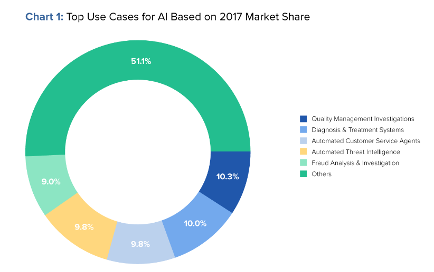
Artificial intelligence can successfully identify and stop fraudulent actions and shield firms from monetary losses by utilizing machine learning algorithms and predictive analytics. Systems for detecting fraud using AI can analyze a lot of data, spot questionable transactions, and spot trends and behaviors that can point to fraud. To simplify, behaviors, locations and buying habits are frequently analyzed and if suspicious activity is detected a security mechanism is triggered (Arthur Bachinskiy, February 2019). This improves the financial market’s overall stability and security. This is also the case for credit scoring. This proactive strategy contributes to the preservation of the financial market’s trust and confidence, creating a safer environment for both enterprises and customers, knowing that the risk of fraudulent behavior has been minimized due to AI. In a large variety of industries, including finance, banking, insurance, healthcare and retail, AI-based fraud detection systems can be used to spot fraud-related actions like identity theft, payment fraud, healthcare fraud and many more. AI has been tackling financial fraud quite successfully for numerous years. Based on the 2017 market share, fraud analysis and investigation accounted for 9% (as shown in the graph above) of the top use cases for AI, highlighting the significance of fraud detection. Nearly 10% of the top use cases for AI were related to fraud analysis and investigation. Therefore could majorly affect financial markets (Melissa Lin, n.d.).
Credit scoring
Firstly, what is credit scoring? “Credit scoring is a statistical analysis performed by lenders and financial institutions to determine the creditworthiness of an individual or a small business” (Thomas Brock & The Investopedia Team, March 2023). AI can also be used to create prediction models that estimate a borrower’s chance of defaulting on a loan. These models can use a wide range of variables, including income, debt-to-income ratios, and payment histories, to more accurately anticipate the risk involved with lending to a certain borrower. Similarly to how AI is used in fraud detection, it also automates tasks, reducing prejudice, and personalizes the lending process for better credit score while also analyzing data such as: employment status, credit history, income and more for accurate risk assessment (Alice Ivey, May, 2023).
There are many ways in which AI is used in fraud detection such as:
- Automated anomaly detection – Transactional fraud monitoring systems are trained to spot patterns in data that point to fraudulent behavior. These patterns can include out-of-the-ordinary transaction quantities, numerous transactions done from the same device, or quick purchases made from various locations. The transaction will be flagged for additional examination once the AI notices an irregularity.
- Behavioral analysis – Analyzing client behavior trends over time will help spot strange behaviors. E.g: recognise abnormal or large transactions. AI then flags this behavior.
- Natural Language Processing (NLP)– NLP can be used by AI algorithms to examine consumer communications, such emails or chat transcripts, to find signs of fraud by allowing computers to understand and interpret human language.
- Continuous learning – The accuracy and efficiency of AI can be improved overtime by training them with new information. Through continuous learning, fraud detections are kept updated with the most recent fraud trends and approaches.
These methods also apply to credit scoring. However, the functions differ to relate with risks associated with granting credit.
Fraud detection case study
The notorious financial crime known as money laundering is also detected and prevented by banks using artificial intelligence. The expense of the suspected money-laundering investigations is reduced by machines that can identify questionable activities. A specific case where AI has been implemented would be Danske Bank, a Nordic universal bank. A modernization of the bank’s fraud detection defenses was necessary. Due to the old methods of fraud detection, only 40 percent of frauds were detected and up to 1,200 false positives were recorded each day by the bank, as a result. In addition, 99.5% of all cases were not fraud-related (Teradata Corporation, 2018). Investing substantial resources, time, and money in investigating false alarms that ultimately proved to be dead ends was unnecessary due to the large number of false alarms. Danske Bank decided to work with Teradata Consulting to apply innovative analytic techniques, including artificial intelligence, to identify fraud more effectively. Danske Bank successfully adopted a cutting-edge business analytic solution utilizing AI, and the results were impressive. AI-based systems, as the one Danske Bank uses, improve market stability and security by efficiently focusing resources on only actual cases of fraud. False positives were reduced by 60%, and experts predict that number to rise to as much as 80%, as well as a 50% increase in true positives, therefore more efficiently preventing fraudulent activities, while saving resources (like people, time and money). Therefore, their profits increase and it increases the stability and security of the financial market (Teradata Corporation, 2018).
Effects on the financial market due to both credit scoring and fraud detection
AI in Fraud detection improves the financial market’s overall stability and security. Without AI, a country’s financial market could become unreliable and insecure, which can have a number of detrimental impacts:
- First, a drop in investor confidence could result in fewer investments and capital inflows. This could restrict the expansion and growth of the economy.
- Second, firms might have trouble getting finance, which would limit their ability to invest and grow.
- Third, customers may become more conservative and cut back on their spending, which would limit the demand for products and services.
- Additionally, a volatile and unsafe financial market can result in currency devaluation, inflation, and increased interest rates, which can further affect consumers and businesses.
In general, an unstable and unreliable financial market can produce a downward spiral of the economy of a country,causing economic instability. This is why AI is crucial in fraud detection systems and credit scoring to maintain a stable and secure financial market (Dan Washmuth, May 2022).
AI’s Effects on Banking Security and Corruption in Current and Future Banking Systems
How AI Could Revolutionize Banking Fraud– Both Positively and Negatively
Although ‘good’ and ‘bad’ are subjective terms, ‘illegal’ and ‘legal’ are not. AI has the potential to be used legally and illegally in the financial fraud industry.
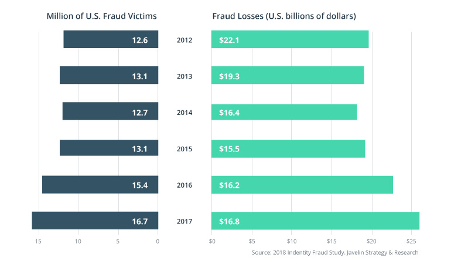
What is Banking Fraud?
Financial fraud plagues banking systems around the globe. Currently, the fraud business costs the banking industry $67 billion every year. In 2022, financial fraud cost the corporate sector around $4.7 trillion globally. New technology often drives an increase in many types of banking frauds, such as account takeover fraud, card fraud, and peer-to-peer payment fraud. However, AI could be a positive outlier. AI is becoming more common throughout the financial sector, especially through machine learning (ML) systems and the financial technology (fintech) industry. AI and ML systems have been improving client services in banking, making transactions easier, investing simpler, and borrowing smoother. AI and ML systems have also improved things for banks themselves. Many banking services have dramatically decreased in price for both clients and financial service providers, as many financial services can now be done using automated processes, instead of human labor and calculations. AI has also been used for risk assessment and management in many banking systems, usually providing more accurate results than many traditional statistical models (NetGaurdians, 2023).
Benefits of AI in Banking Fraud
Artificial intelligence and machine learning have many benefits, among which is their ability to prevent and detect banking fraud. AI can process huge amounts of data in seconds, recognize intricate patterns in minutes that would take humans hours to figure out, and predict future scenarios based on past data. These skills are extremely useful when it comes to fraud detection and fraud prevention. The fact that they can be done by a technological system is also beneficial to many financial service providers, as it greatly reduces the cost of fraud detection and prevention. One of the main benefits AI offers in fraud detection is real-time detection. Using its ability to rapidly assess patterns, many artificial intelligence programs can detect clients’ normal spending patterns, therefore also detecting when clients start spending abnormally. Being able to recognize these patterns rapidly prevents fraud from happening in the first place, which is the most effective way to stop fraud in general (SQN Banking Systems, 2022).
Identity fraud is one of the most common types of banking fraud in the industry. Formation of false identification, use of false applications, forged IDs, and illegal purchase of consumer identifications are all very common scams seen today. Given enough data, machine learning algorithms and AI-powered programs can use neural networks to differentiate between real and fraudulent IDs. This programming could potentially be implemented in payment applications, decreasing the cost of the verification and purchasing process. Some banks are also starting to look at the use of AI for this purpose because of the security it can provide consumers. The more data the AI program is fed, the more accurate its ability to detect fake IDs would become, eventually building a fool-proof system (Anjum Khurshid, 2019).
Disadvantages of AI in Banking Fraud
Giving artificial intelligence more power in the banking fraud industry can be a dangerous game, however, both to consumers and banks themselves. Many fraudsters use new technologies to carry out sophisticated scams – ones that have not been seen before. Artificial intelligence can also help people brainstorm new ideas for fraudulent scams using fabricated information. In early 2020, a group of scammers used artificial intelligence to clone the voice of a company director in Dubai. They called a branch manager of the company, using the AI-copied voice, and told him to wire $35 million to be used in some company acquisitions. The branch manager believed it to be his director, and wired the money over. Since AI is a relatively new technology, no one had ever seen a scam like this before, nor would any average person known to have expected it. Herein lies the most pressing concern of new AI technology being used in the banking industry: nobody knows what to expect (Thomas Brewster, 2021).
Other technology experts are concerned about the ease with which artificial intelligence can spread misinformation. Videos already circle on social media of Joe Biden urging American citizens to sign up for extra Social Security benefits. However, although the video seems real, the social security benefits are not. Gail Ennis, inspector general at the Social Security Administration’s Office of the Inspector General, wrote in July that “criminals will use AI to make fraudulent schemes easier and faster to execute, the deceptions more credible and realistic, and the fraud more profitable”. Government agencies have tried setting up task forces to investigate possible scams involving AI, but they admit that they are already “behind the curve”. Since AI is so new, even the most well-funded government groups do not have the resources to deal with artificial intelligence-powered scams. Haywood Talcove, CEO of the Government business LexisNexis Risk Solutions says that “[LexisNexis Risk Solutions does not] have years, months or weeks to study [artificial intelligence], because it is here right now” (Lorie Konish, 2023).
Potential Future Regulations on Artificial Intelligence in Banking
Since artificial intelligence has such a propensity for both illegal and legal activities, it is important that it is regulated properly in the future. Financial advisors suggest that there needs to be a balance when regulating AI between fostering innovation and minimizing risks. One of the main concerns people have with artificial intelligence is the lack of transparency given for how the AI got its information. This is a problem especially with machine learning programs. This being the case, a traditional regulatory framework relying on transparency might not be applicable when managing AI. There is also a lot of bias involved in an artificially intelligent algorithm’s decision-making. The quality of an AI’s output is dependent on not only the data fed to the algorithm, but also the phrasing and framework of the task or question requested. Again, this requires more creative thinking for regulating AI. The third argument for untraditional regulation of artificial intelligence is the potential stability risks AI poses. If machine-learning algorithms universally adhere to a previously successful decision-making pattern, it could result in a herding mindset. This phenomenon holds the capacity to magnify market disturbances or increase financial risks (Jan-Thomas Schoeps, 2019).
Currently, different governments are reacting very differently to artificial intelligence in the banking sector. The US Treasury Department released a report, adopting the process of “competitive technologies” in the finance sector. The Financial Stability Board publicly acknowledged the benefits of AI programs to consumers and banks. The Fed also supports banks adopting AI technology because it is concerned that non-regulated organizations – such as fraudsters – might gain an advantage from using AI. The EU has adopted the strictest rules on AI, which will have a global impact. China has also adopted very harsh rules regarding AI, but the effects of this will be mostly domestic. The regulation of AI will further contribute to global decentralization, a growing trend in the tech world (William Howey, 2023).
However, it still remains to be seen how artificial intelligence will be regulated in the future. The Fed has said that it will rely on existing regulatory and supervisory “guardrails” to manage AI processes, but existing regulations may not be sufficient. AI is changing the world, which means that banks and regulators alike have to determine how to change with it.
AI’s impact on ESG investments
What is ESG?
ESG is an acronym for Environment, Social and Governance. In recent years there’s been a significant popularity of these investments. ESG related issues have given rise to divisive political views in the USA. More companies and investment funds are adopting policies or programs that correlate to ESG measures as they look to drive profitability and improve access to the capital. Investors are now developing ESG investing strategies and have given more focus on the environment, social responsibility and implementing corporate policies.
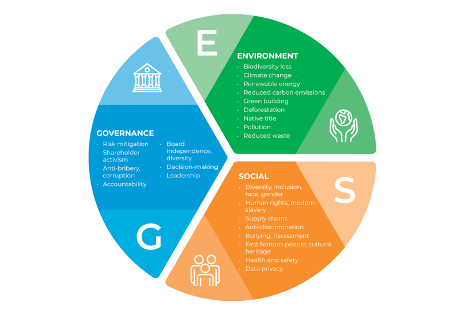
ESG also helps to measure how a company operates and its impact on today’s issues. Companies with strong ESG practices often prioritize reducing carbon footprint, promoting diversity and inclusion, while maintaining transparent and ethical business practices. Overall ESG factors evaluate a company’s relation in society and the quality of corporate governance. It’s critical to have these components when assessing a company’s long-term viability.
Market growth
There’s been rapid growth in the global ESG and sustainability consulting market. Its estimated value is US$39.3 billion in 2021 (Beth Snyder Bulik, 2021) and is expected to increase at a compound annual growth (CAGR) of 6.3% during 2023-2033. The world seems to be more concerned about climate change and sustainability. Topics such as renewable energy, water shortages and greenhouse emissions have become mainstream in the last five to seven years. The corporate world has now blown the money out of their wallets in making changes for the operation net-zero. This has led to more demand in investment products because companies are recognizing the value of integrating ESG considerations into their operation. According to data from the US Sustainable Investment Forum (USSIF, 2023), ESG investing has gained momentum and has become more than just a niche market. This growth can be attributed to the increasing awareness and demand for sustainable and ethical investment options.
AI’s Impact on ESG
According to the World Economic Forum article (Davos Agenda, 2023), there’s been a rise in laws mandating ESG metrics in the past two years. The European Commision proposed for companies to report on social and environmental impacts for 2024. Additionally, in August 2022, the US Securities and Exchange Commission proposed regulations to enhance and standardize disclosures related to climate. However, most corporations aren’t prepared to meet these new standards. They will need automated solutions that merge data and offer comprehensive emissions-tracking functionalities along with broader ESG performance management. Artificial intelligence (AI) plays a pivotal role in creating a solution and for ESG investments.
1. Data Driven Decision Making
With the help of AI algorithms, investors can now analyze vast amounts of data to identify companies that align with ESG principles. For instance, AI’s ability to process and analyze large volumes of data is crucial for effective ESG decision-making. Companies can use AI to identify trends, risks, and opportunities related to ESG factors. This data-driven approach can lead to more informed investment strategies, allowing investors to allocate capital to companies that align with their ESG priorities.
2. Sentiment Analysis
This algorithm allows computers to analyze the tone of words used by comparing existing information. This is called a sentiment analysis program, and it’s trained to identify a caller’s conversation and tone. Its incredible ability to recognize language and process the topics discussed is beneficial to gather feedback on ESG initiatives. Gathering information will improve ESG performance and will help build trust with stakeholders. AI also branches into Natural Language Processing (NLP), a method of communicating just like humans do. For instance our most popular smart assistants, Alexa and Seri use natural language generation
3. Measuring Impact
AI can provide analytics and communicate sustainability efforts from a company. AI is capable of making predictions from data analysis and enhancing decision making. For instance AI’s algorithms can see how much green gas emissions have been reduced from renewable energy investments, and from employee satisfaction due to its diverse environment and inclusion programs. Measuring the impact of ESG initiatives are crucial for accountability.
4. Enhancing Security
Corporate governance is important for helping investors make informed decisions. AI improves transparency by using blockchain to tamper proof records of transactions and analyzing documents. The security from blockchain can reduce attack vectors and potential fraud.
In essence, AI algorithms bring speed, accuracy, and depth to ESG investments, enabling investors to make more informed decisions that align with their ethical values while also considering financial goals. By leveraging AI’s capabilities, investors can navigate the complexities of ESG factors and contribute to a more sustainable and responsible investment landscape.
AI has taken off in leaps over recent years in major businesses. There’s been significant advancements as well as some ethical considerations to address. AI algorithms can magnify biases present in data, resulting in unjust decisions. USC researchers discovered a bias of 38.6% in the facts used by AI. Another report about the bias has been stated from Stanford University, saying that AI displayed a correlation between fairness and bias contrary to expectations, models that excelled in fairness metrics exhibited heightened gender bias, while less gender-biased models showcased greater toxicity. Overall AI should be integrated as a powerful tool to enhance, not to replace human judgment and due diligence.
Conclusion
To summarize, AI has developed from a purely theoretical idea to a real technology that affects our daily lives. AI and humans are increasingly interacting with one another. However, there is a concern that AI will become unpredictable and unstable and may eventually replace humans and our employment. However in this article, we have established that this will not be the case and instead has created more high paying jobs and has created a more stable and secure financial market. AI continues to evolve and will anticipate its role in the financial world by expanding beyond its current applicants. The potential benefits are vast by enhancing efficiency, and data-driven insights, the ability to understand risk factors, and improving customer experience.
In addition to this, AI is also thriving in fraud detection by using predictive analytics as well as machine learning algorithms and AI is able to identify and prevent fraudulent activities. It’s capable of conducting extensive data analysis, locating questionable transactions and spotting trends in data. This forward-thinking approach enhances the security and stability of the financial market while upholding the confidence and trust for both its consumers/customers and enterprises. There’s no denying that AI is a brilliant tool and has revolutionized the finance industry. With careful consideration of ethical and regulatory aspects, AI will pave the way for a more adaptive and resilient financial sector.
Bibliography
Cornell University (September 22, 2020) “An AI-oriented Quantitative Investment Platform.” https://arxiv.org/abs/2009.11189
Margaretta Colangelo (February 20, 2020) “Mass Adoption Of AI In Financial Services Expected Within Two Years.” https://www.forbes.com/sites/cognitiveworld/2020/02/20/mass-adoption-of-ai-in-financial-services-expected-within-two-years/?sh=4f8e8ba57d71
Jennifer Conway Viriato (2019) “AI and Machine Learning in Real Estate Investment.” https://www.pm-research.com/content/iijpormgmt/45/7/43
Author Not Listed (June 9, 2023) “The Future of Finance: AI’s Impact on Banking and Investment.” https://medium.com/@Imaginovation/the-future-of-finance-ais-impact-on-banking-and-investment-ca6859cc1ba1#:~:text=A.,-Advanced%20Predictive%20Analytics&text=With%20machine%20learning%20models%20becoming,financial%20products%20for%20individual%20customers.
Pragati Baheti (August 31, 2022) “9 Innovative Use Cases of AI in Finance.” https://www.v7labs.com/blog/ai-in-finance
Banking, SQN. “Artificial Intelligence in Bank Fraud Detection and Prevention.” SQN Banking Systems, October 7, 2022. https://sqnbankingsystems.com/blog/artificial-intelligence-in-bank-fraud-detection-and-prevention/#:~:text=AI%20can%20also%20support%20the,strengthen%20your%20fraud%20detection%20efforts .
Brewster, Thomas. “Fraudsters Cloned Company Director’s Voice in $35 Million Heist, Police Find.” Forbes, October 14, 2021. https://www.forbes.com/sites/thomasbrewster/2021/10/14/huge-bank-fraud-uses-deep-fake-voice-tech-to-steal-millions/?sh=574cc84c7559.
Howey, William. “How Governments Are Looking to Regulate AI.” Economist Intelligence Unit, July 21, 2023. https://www.eiu.com/n/how-governments-are-looking-to-regulate-ai/.
Khurshid, Anjum. “Banking on Artificial Intelligence (AI).” Wipro, 2019. https://www.wipro.com/business-process/why-banks-need-artificial-intelligence/.
Konish, Lorie. “As Social Security Official Warns of A.I. Fraud Risks, One Expert Says Criminal Activity Is ‘Here Right Now.’” CNBC, August 2, 2023. https://www.cnbc.com/2023/08/02/how-ai-may-make-social-security-fraud-easier-and-faster-to-execute.html.
NetGaurdians, ed. “All about Banking Fraud – the What, Why, and How.” NetGuardians, March 1, 2021. https://www.netguardians.ch/banking-fraud/.
Jan-Thomas Schoeps “Regulating AI in the Banking Space: A Call to Action.” Deloitte United States, July 10, 2019. https://www2.deloitte.com/us/en/pages/financial-services/articles/regulating-ai-in-the-banking-space.html.
Dan Washmuth, instructed by Patricia Jankowski “stock market fluctuations” and “what is economic instability” (May, 2022) <https://study.com/learn/lesson/economic-instability-causes-examples-what-is-economic-instability.htm>
Teradata corporation (2018) “Danske bank fights fraud with deep learning AI” <https://assets.teradata.com/resourceCenter/downloads/CaseStudies/CaseStudy_EB9821_Danske_Bank_Fights_Fraud.pdf>
Alice Ivey (May 5, 2023) “How can AI be used to improve credit scoring?” <https://cointelegraph.com/news/how-can-ai-be-used-to-improve-credit-scoring>
Thomas Brock and the investopedia team ( March 23, 2023) “What Is Credit Scoring? Purpose, Factors, and Role In Lending” <https://www.investopedia.com/terms/c/credit_scoring.asp#:~:text=Credit%20scoring%20is%20a%20statistical,to%20extend%20or%20deny%20credit.>
Ryan Heath, ‘ Under attack, ESG investing finds an AI savior ‘ ( June 1, 2023) < https://www.axios.com/2023/06/01/esg-investing-ai-culture-wars-supply-chains
Deborah Yang ‘ How generative AI can help individuals invest in ESG- forward companies’ (August 1, 2023) <https://www.fastcompany.com/90930815/how-generative-ai-can-help-individuals-invest-in-esg-forward-companies
Hayung Kim ‘ ESG concerns are growing as artificial intelligence becomes more popular. What investors need to know’ ( May 10, 2023) <https://www.cnbc.com/2023/05/10/esg-concerns-are-growing-as-ai-becomes-more-popular-what-investors-need-to-know.html
Arthur Bachinskiy (February 21, 2019) “The Growing Impact of AI in Financial Services: Six Examples” <https://towardsdatascience.com/the-growing-impact-of-ai-in-financial-services-six-examples-da386c0301b2>
Melissa Lin “How Artificial Intelligence Is Disrupting Finance” <https://www.toptal.com/finance/market-research-analysts/artificial-intelligence-in-finance>
Davos Agenda “What is ESG and how it can lead to sustainable economic growth” https://www.weforum.org/agenda/2023/01/the-importance-of-esg-sustainable-future-davos-2023/




